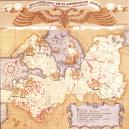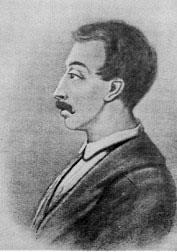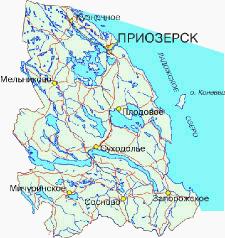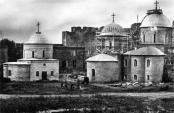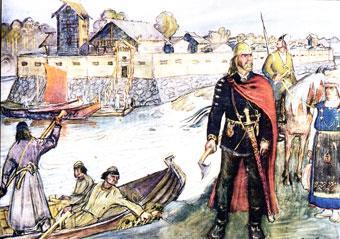Articles
/
Korela, fortress, the
Korela, fortress, the
Subject /
Architecture/Fortresses and other fortifications
Subject /
Ethnic culture/Ethnic communities/
Subject /
Ethnic culture//
The Korela fortress (the town of Priozersk located on the bank of the River Vuoksa). The historic names: Kyakisalmi ("The Cuckoo Strait"; the Karelian name), Karelian Town (the Novgorod name), Korela (the Moscow name), Keksgolm (the Swedish name). The fortress was firstly mentioned in the chronicle in 1143. The detinets ("The Old fortress") was located on an island with the area 6000 square metres. Wooden and earthwork fortifications were built by the Novgorod people in 1310, in 1364 they were expanded with a stone tower built by the Novgorod Governor Yakov. Two building horizons of 1310-1360 and 1365-1380 were found by excavations. Old Russian things and Karelian jewellery were found. In 1295, 1314 and 1337 Swedes conquered the town, but the Novgorod people recovered it. Swedes attacks were repulsed in 1322 and 1348. Spassky Island ("The New Fortress") was settled in the late 15th century. During the archeological dig posad building horizons of 1481-1500 and 1513-1525 were found. In the 1570s the posad was carried around with wooden and earthwork fortifications, the island was cut with a canal. Both islands fortifications became to look like bastions, wooden towers covered in clay were constructed on orillions-bulwarks. During the time of the Livonian War the fortress had stood up against Swedes in 1573 and 1578. In 1580 it was taken by the troops of P. Delagardi. Swedes reconstructed the detinets, they built a round two-high tower over the entrance (1582-1585) and "The Old Arsenal" (1591), rondels - semicircular stone structures in a fortress were constructed on places where towers were places formerly (1585-90). Wooden walls on the top of earth curtains were clayed and padded with soil. Bastions were made on the places of burned towers of Spassky island. According the Tyavzinsky treaty of 1595 the fortress was returned to Russia in 1597. In 1611 Swedes won the town after the 6-month siege. According to the Stolbovsky treaty of 1617 The Korela fortress became the part of Sweden. In the 17th century cannon batteries, bastions and curtains were faced with stone, the fortress governor's house and a complex of barracks were built in the detinets, a Lutheran church was built on Spassky Island. During the North War in 1710 the fortress was won by the Russian forces under the command of R. Bryus. In October 1710 Peter I visited the fortress and gave instructions about reconstruction of the fortress. In 1710 in commemoration of the victories over the Swedes the southern gate of "The New Fortress" were faced with captured armour. In the 18th century new stone constructions were made. The fortress was preserving the military importance till 1810. In 1762 ex-emperor Ioann VI Antonovich was put into the fortress for the short time , since then the fortress was used as a political prison. Since 1775 E.I. Pugachev's family was being imprisoned there for a long time, in 1826-27 the decembrists M.K. Kyukhelbeker, A.P. Baryatinsky, F.F. Vadkovsky, I.I. Gorbachevsky, A.V. Podzhio, M.M. Spiridov were imprisoned in the fortress, in 1849 R.A. Chernosvitov, a member of the Petrashevsky Circle, was put there. The archeological dig was made by T. Shvindt in 1891, by A.N. Kirpichnikov 1972-73 and in 1975-76, by A.I. Saksa in 1989-90. Since 1962 the Local History Museum has been working in the fortress. The restoration works were made in the 1970-80s.
Authors
Plotkin, Konstantin Moiseyevich
Persons
Baryatinsky, Aleksandr Petrovich, Prince
Bryus, Roman Villimovich
Chrnosvitov, Rafail Aleksandrovich
De la Gardie, Pontus
Gorbachevsky, Ivan Ivanovich
Ioann VI Antonovich, Emperor
Kirpichnikov, Anatoly Nikolayevich
Kuhelbeker, Mikhail Karlovich
Peter I, Emperor
Podzhio, Aleksandr Victorovich
Pugachev, Yemelyan Ivanovich
Saksa, Aleksandr Ivanovich
Schwindt, Theodor
Spiridov, Mikhail Matveyevich
Vadkovsky, Fyodor Fyodorovich
Geography
Leningrad Oblast, the/Priozersk District/Priozersk Town
Topographical landmarks/Vuoksa River, the
Bibliography
Кирпичников А.Н. Башня посадника Якова в средневековой Кореле // Древняя Русь и славяне. М. 1978., 352-358
Кирпичников А.Н. Историко-археологические исследования древней Корелы («Корельский город» XIV в.) // Финно-угры и славяне. Л. 1979., 52-73
Кирпичников А.Н. Каменные крепости Новгородской земли. Л., 1984, 119-144
Subject Index
"Korela", a museum-fortress
Mentioned in articles:
|
hidden
|
Archaeological monuments
Archaeological monuments of the Leningrad Oblast are settlements, grads, burial grounds, religious objects and other material trails of the past. Settling the oblast territory took place during the Mesolithic period. The age of the most ancient... more
|
|
|
|
hidden
|
Keksgolm Fortress, see Korela, fortress
reference
|
|
|
hidden
|
Kyukhelbeker, Vilhelm Karlovich (1797-1846), a poet
Vilhelm Karlovich Kyukhelbeker (1797-1846), poet, revolutionary(Decembrist). Upon finishing the Imperial Lyceum at Tsarskoye Selo (1817;A.S.Pushkin's classmate) served in the Ministry of Foreign Affairs and at the same time he taught Russian... more
|
|
|
|
hidden
|
Priozersk District
PRIOZERSK DISTRICT, municipal entity. Population: 63,300 (of these, 20,500 live in Priozersk town, the adm. center.) Area: 3,563.1 sq. km. Located in the eastern and north-eastern parts of the Karelian Isthmus. It borders Vsevolozhsk and Vyborg... more
|
|
|
|
hidden
|
Priozersk, town
PRIOZERSK (Korela; Kexholm until 1948; Finnish Käkisalmi,) town, adm. center of Priozersk District. Population: 19,300. From 1310, the center of Russian possessions in Karelia. It belonged to Sweden in 1580-95 and in 1611-1710. It became territory... more
|
|
|
|
hidden
|
Restoration of buildings of architectural and historic interest.
Restoration of buildings of architectural and historic interest. The first experience of the research restoration of the Russian Middle Ages monuments in the territory of the pesent-day Leningrad Oblast dates from 1846-1847, when in the Ivangorod... more
|
|
|
|
hidden
|
Tiversk military post, a fortress
Tiversk military post, a fortress (Priozersk district, in 3.5 km to south from Vasilevo Settlement).
The reinforced settlement on island in the middle of the Vuoksa River, near the Tiuri rapids that was tribal and handicraft centre of the Karelian.... more
|
|
|
|
hidden
|
|






